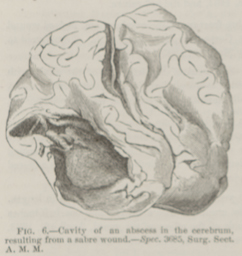Title: H——, James
Source text: Surgeon General Joseph K. Barnes, United States Army, The Medical and Surgical History of the War of the Rebellion. (1861–65.), Part 1, Volume 2 (Washington, D.C.: Government Printing Office, 1870), 19-20.
Civil War Washington ID: med.d1e2085
TEI/XML: med.d1e2085.xml
H——, JAMES, Private, 27th Company, 2d Battalion, Veteran Reserve Corps, aged 22 years, a patient at Ricord Hospital, Washington, in an altercation with one of the hospital guards, on the 25th of January, 1865, received a sabre wound, two and a half inches in length, on the left side of the forehead, a little within the left frontal protuberance. A cleft, an inch long, was made in the outer table of the bone. The patient was conveyed into the hospital, and the wound was closed by silver sutures, and simple dressings were applied, and he was restricted to low diet. On the 25th, the man was feverish, and his bowels were constipated. He had a dose of salts, which was repeated on the 27th. On the 28th, he complained of headache, and was ordered a mixture with bromide of potassium, lupulin, and hyoscyamus, and was allowed full diet. On the 31st, the report says that his appetite was good, but he was ordered a drachm of tincture of gentian thrice daily. On February 2d, he was reported as having passed a restless night, and was ordered eight grains of Dover's powder at bedtime. On February 6th, he was very comfortable, and walked about the ward. On the next day, his bowels being sluggish, he took three grains of blue pill and six of the compound extract of colocynth, and was placed on light diet. On the afternoon of the 8th, he complained of headache, which was aggravated at night. On the next morning he was partially insensible. He was roused with difficulty; he answered questions slowly, but rationally. The pupils responded to light; the tongue when protruded, after great effort, did not deviate laterally. He had a dose of salts, a blister, three by five, to the nucha, and, later in the day, a terebinthinate enema. He had several involuntary dejections, and his urine dribbled away. In the evening he seemed brighter, and the control of the sphincters was re-established. On February 10th, he was perfectly rational. The urine and fæces were discharged voluntarily; the tongue when protruded deviated slightly to the right; the pulse was weak at 70; slight cephalalgia. February 11th, he had passed a bad night, and he had but little appetite. From the 12th to the 15th, anorexia, weak pulse, regular bowels, no aggravation of the head symptoms. On the 16th, the patient complained of severe headache at 4 A. M., and soon after began to breathe stertorously. At 7 o'clock he was perfectly unconscious; the pupils were slightly but equally contracted, and did not respond to light; there was stertor, with foam about the lips. Coma became more and more profound, and at half past twelve on the following day, February 17th, 1865, the patient expired. At the autopsy, an incised fracture, an inch long, involving the outer table only, was found near the left frontal protuberance. The condition of the diploe beneath it is not mentioned. The left side of the os frontis was sent to the Army Medical Museum. It is numbered Specimen 3684 of the Surgical Section, and is figured by a wood-cut on page 34 of the Catalogue.⃰ Two discolored spots on the specimen are stains from iron rust, accidentally made during the preparation of the specimen. An abscess was found in the left anterior lobe of the cerebrum, measuring two and one-half inches antero-posteriorly, and one and one-half inch laterally, the anterior and superior portions extending on the left nearly to the surface of the cerebral substance, and within six lines of the median line of the cerebrum. It contained two ounces of pus. Pus had also found its way through all the ventricles, largely distending the left lateral, and, from the fourth ventricle, had passed between the substance of the medulla oblongata and its membranes as low as the origin of the twelfth nerve. The boundaries of the upper and posterior portions of the abscess are indicated in FIG. 6. Specimen 3571 of the Surgical Section of the Army Medical Museum shows the remaining portion of the abscess.
⃰ Catalogue of the Surgical Section of the United States Army Medical Museum, Washington, 1866, p. 34.
